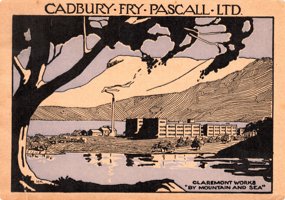ENERGY CHOCOLATE
The idea for the famous bush-walkers’ friend “ENERGY” chocolate came from a keen bushwalker and company director in Cadbury’s Claremont in the 1920s. He knew from experience that walking is hot work and milk chocolate melts at a low temperature. He asked Cadburys to solve it and they developed the ENERGY recipe out of a blend of mainly dark and some milk chocolate with malt, later adding ground almond meal.
The new chocolate’s wrapper was drawn and designed by Vern Hodgeman and featured a pair of bushwalkers. The increasing and then decreasing size of the letters in the word ENERGY mimics the profile of the mountain. In 1936 Hodgeman re-drew the figures to illustrate the (now-famous) Hobart Walking Club’s Mountain Roads and Tracks map.
Chocolate boxes on the left, Walk map on the right.
The font was designed to mimic the mountain’s skyline
The chocolate was popular until the 1980s and is still made at Cadburys for internal blending. ENERGY is retailed in New Zealand and has been their best selling dark chocolate since 1934. The recipe—which is one of only two created by Cadbury that succeeded—was popular for sixty years. (The second recipe was a high-energy, military version of ENERGY.)
Advertised as “smooth, energising and sustaining. The Great Outdoors Companion” it was said to be ideal for motoring, hiking and all outdoor sports. Christoph Bartneck contacted Cadbury about their secret, energy ingredient and was informed that in 1936 Cadbury used the block’s calorie value to justify the name. It contains 2200kJ per 100 gr. Bartneck pointed out, however, that today Dairy Milk Chocolate contains 40kj more and Cadbury Dream contains 150kJ more (2350kJ) than ENERGY.
The calories in the Dream and in Dairy Milk are predominantly ‘empty’ calories. It is the portions and minerals in the dark chocolate, almond meal and malted barley have greater nutritive value.













